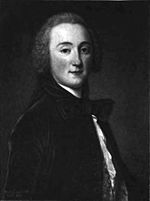- David Wemyss, 6th Earl of Wemyss
-
David Wemyss, de jure 6th Earl of Wemyss (12 August 1721 - 29 April 1787), generally known as Lord Elcho even after his father's death, was a Scottish peer and Jacobite army officer.
Contents
Life
Elcho was the eldest son and heir of James Wemyss, 5th Earl of Wemyss, and his wife Janet (d. 1778), daughter of Colonel Francis Charteris and Helen Swinton. His parents separated in 1732. He was educated at Winchester College, (1734 to 1738), and at the military academy at Angers. Elcho was in Rome from October 1740 until April 1741, where, he met James Stuart (Stuart claimant to the throne). He was appointed a colonel of dragoons in February 1744 and was a member of the Royal Company of Archers.
Elcho joined Prince Charles Edward Stuart at Gray's Mill, near Edinburgh, on 16 September 1745, when he became the prince's first aide-de-camp and an original member of his council. Elcho fought at the Battle of Prestonpans on 21 September 1745. Elcho was one of the majority who at a council of war held at Derby in December 1745 advised the prince to return to Scotland rather than advance further into England and face almost certain death. Later Elcho was present on 17 January 1746 at the siege of Falkirk and on 16 April 1745 at the battle of Culloden, at which Charles's army was defeated by English forces under the command of the Duke of Cumberland. Elcho, together with the Duke of Perth and other leaders of the Jacobite forces, escaped to France in the frigate Mars on 3 May 1746.
Elcho never returned to Britain, and for his part in the rising he was subject to the act of attainder passed in 1746 and his titles and lands were forfeited. In spite of this, he assumed the title of 6th Earl of Wemyss on his father's death on 21 March 1756, although he was generally known as Lord Elcho.
Elcho continued his military career in France, where he entered the service of Louis XV and held two unpaid offices, captain in the Fitzjames's regiment, and colonel in the Royal Scots. In the latter post Elcho was with his regiment at Gravelines from June to October 1757 and then at Dunkirk in 1758. Although he held no other military command, Louis XV conferred the Order of Military Merit upon him in July 1770.
Dividing his time between France and Switzerland, he become naturalized in Neûchatel. On 9 September 1776 Elcho married at Beûtal in Switzerland, baroness Sofie Frederikke Vilhelmine Yxkull-Gyllenband, a daughter (b. 1756) of Baron, later count Karl Gustav Friedrich von Uexkull-Güldenband, the first HRE count of Münchzell, and a minister of Wurttemberg. She died in childbirth on 26 November 1777. Elcho himself died in Paris in 1787, aged sixty-five, and was buried with his wife at Bôle in Switzerland.
Lord Elcho's Narrative
David, Lord Elcho left two manuscripts: (1) a journal in French, covering the principal years of his life; (2) a narrative of the events in 1745-46. The narrative closely agrees with Blaikie's Itinerary of Prince Charles Stuart. Comparing the narrative with Tales of a Grandfather shows that Sir Walter Scott was given the opportunity of studying the narrative and that he adopted it as the principal authority for his history of the events of 1745.[1]
According to Alice Wemyss in her book 'Elcho of the '45' (ISBN 0-85-411080-1) page 222, David, Lord Elcho, "...died in Paris 'on April 30 1787 in his house rue St Lazard as the result of illness and in the Protestant faith,'" "Elcho was accompanied to his last resting place by Droz (his steward) and two officers from the Swiss Guard. The cemetery was soon to be vandalised during the Revolution. Thus it is that his bones do not lie, as had been his wish, beside those of his wife." His wife was buried in Bôle, Switzerland.
References
- "Wemyss, David", on the website of the Oxford Dictionary of National Biography (Subscription or UK public library membership required), http://dx.doi.org/10.1093/ref:odnb/29036. The first edition of this text is available as an article on Wikisource:
 "Wemyss, David (1721-1787)". Dictionary of National Biography. London: Smith, Elder & Co. 1885–1900.
"Wemyss, David (1721-1787)". Dictionary of National Biography. London: Smith, Elder & Co. 1885–1900.
Also according to Alice Wemyss, David, Lord Elcho, sailed from Scotland in La Bellone rather than Le Mars, both vessels seemingly sailing together. Quoting the written words of Lord Elcho on (p. 125), Alice Wemyss wrote that Lord Elcho's child, a son, was born on 19th November 1777 but lived for only a day. Seemingly he was not named but on the tombstone in a church at Bôle, Switzerland, he is referred to as "Lord Elcho". His mother was buried with her son. This was David, Lord Elcho's, only legitimate child. Two illegitimate daughters are mentioned in both this book and that of Sir John Wemyss-Kessler, Bt., Scotland the Brave (ISBN 978-0-7884-1582-1).
Notes
- ^ David, Lord Elcho with a memoir and annotations by Evan Charteris (1897), A short account of the affairs of Scotland in the years 1744, 1745, 1746, Edinburgh: David Douglas, http://books.google.com/books?id=T2QDAAAAMAAJ
Peerage of Scotland Preceded by
James WemyssEarl of Wemyss
1756 – 1787Succeeded by
Francis (Wemyss) CharterisCategories:- People of the Jacobite Rising of 1745
- Scottish Jacobites
- 1721 births
- 1787 deaths
- Old Wykehamists
- Naturalised citizens of Switzerland
- Scottish nobility stubs
- "Wemyss, David", on the website of the Oxford Dictionary of National Biography (Subscription or UK public library membership required), http://dx.doi.org/10.1093/ref:odnb/29036. The first edition of this text is available as an article on Wikisource:
Wikimedia Foundation. 2010.

